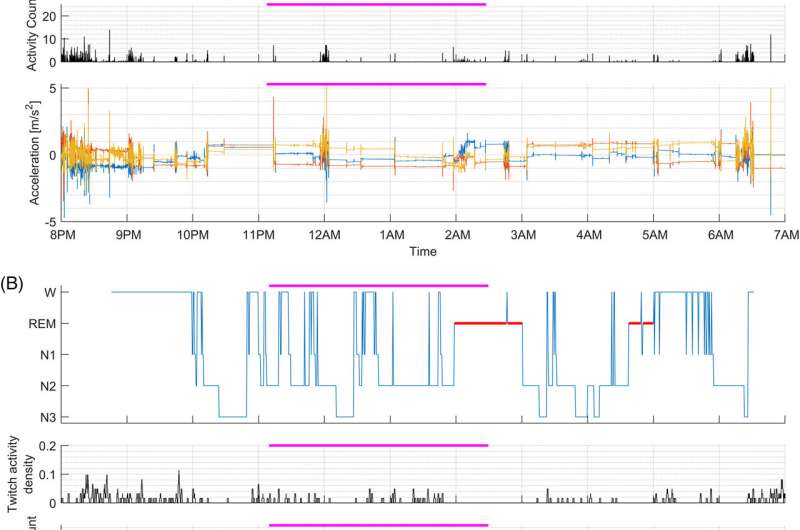This article has been reviewed according to Science X's editorial process and policies. Editors have highlighted the following attributes while ensuring the content's credibility:
fact-checked
trusted source
proofread
Researchers develop one of the first sleep screening methods using wearables to predict, detect Parkinson's onset

Isolated rapid-eye-movement sleep behavior disorder causes abnormal twitches during sleep and episodes of dream enactment including body movement, emotional expression, or audible verbalizations. Isolated rapid-eye-movement sleep behavior disorder is often an early symptom of neurodegenerative disorders that could affect middle-aged and older adults more than a decade later; however, accurate screening methods are currently not available to track this condition.
Researchers have now developed one of the first screening methods during sleep to detect early manifestations of Parkinson's disease—using a non-invasive, low-cost, remote, and scalable technology already embedded in most wearable sleep and fitness trackers known as accelerometers. Accelerometers can monitor movement and rest, and thus inform us about sleep and activity patterns with high accuracy.
The new method is described in a paper published in the journal Movement Disorders.
More than 80 study participants wore the wearable device on their wrist for at least 14 nights, and completed both a questionnaire and a sleep diary reporting any abnormal behaviors during sleep. The researchers analyzed home actigraphy data to determine the participants' movement during sleep and reviewed the nine-item questionnaire from the cohort, which included more than 40 patients with isolated rapid-eye-movement sleep behavior disorder, more than 20 patients with other sleep disorders, and more than 20 patients with no sleep disorders as controls.
The questionnaire asked participants to report experiencing any abnormal movements during sleep, or common early symptoms associated with Parkinson's disease such as loss of smell and dizziness. Using actigraphy data from the wearables, the researchers developed a framework for classification of movements and tested the approach in a machine learning model. Likewise, they also developed an approach from the questionnaire data to test on a machine learning model. Once both actigraphy and questionnaire models were developed, the researchers created a two-dimensional prediction model for isolated rapid-eye-movement sleep behavior disorder.
The actigraphy classifier analyzing movements during sleep could detect isolated rapid-eye-movement sleep behavior disorder with 92.9 percent accuracy. By comparison, all questionnaires combined achieved 91.7 percent accuracy, exceeding the performance of the Innsbruck RBD Inventory questionnaire alone (86.9 percent accuracy). Concordant predictions between actigraphy and questionnaires reached a specificity and precision of 100 percent with 88.1 percent sensitivity, and outperformed any combination of actigraphy and a single question on the questionnaire about early Parkinson's disease symptoms.
More than 1 million adults in the United States display characteristics of sleep disturbances related to Parkinson's disease that are now detectable using simple wearable wrist devices such as an Apple Watch or FitBit. This new screening method could diagnose a very common subtype of Parkinson's disease years before the conventional methods of diagnosis, which require a clinical examination by an experienced neurologist. At-risk populations could receive care and counseling sooner, and receive neuroprotective therapies before the neurodegenerative process has caused irreversible brain damage.
Mount Sinai's Dr. Emmanuel During said of the research, "We need reliable and scalable screening methods for detecting Parkinson's in order to develop effective therapies and select candidates to receive effective therapies. There is now an opportunity for the academic, pharma, and technology sectors to collaboratively partner to develop and apply this prevention screening method in the elderly population at risk for Parkinson's disease."
Researchers from Denmark Technical University and Stanford University contributed to this study. The study was conducted at Stanford Sleep Center from April to December 2021.
More information: Andreas Brink‐Kjaer et al, Ambulatory Detection of Isolated Rapid‐Eye‐Movement Sleep Behavior Disorder Combining Actigraphy and Questionnaire, Movement Disorders (2022). DOI: 10.1002/mds.29249


















